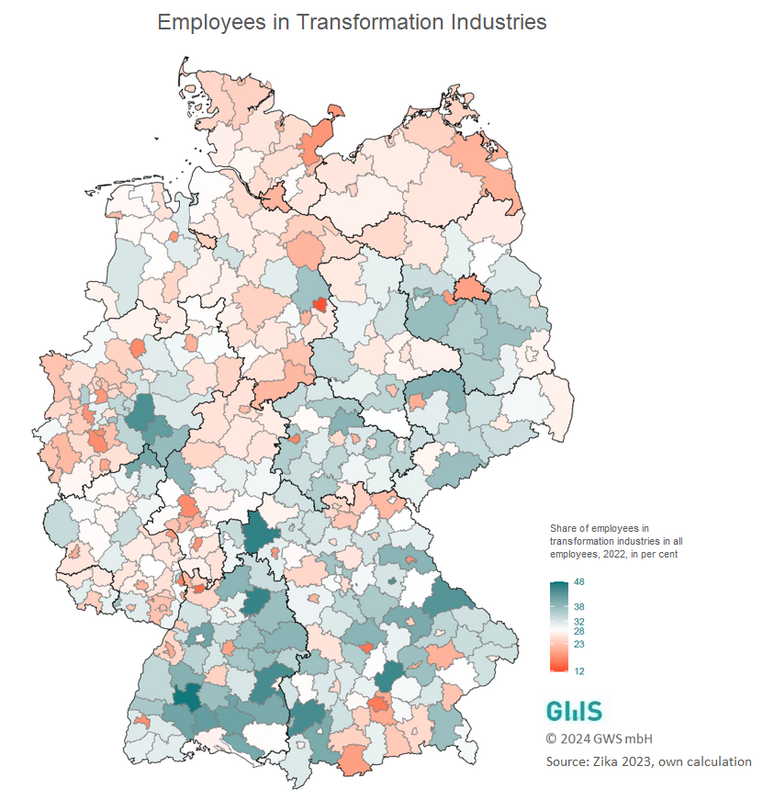Transformation industries in the region
Our figure of the month 03/2024
Germany is facing the challenge of a profound socio-ecological transformation. Climate change, the scarcity of resources and the loss of biodiversity require a fundamental change in our society and economy in order to shape a sustainable future.
The availability of suitable labour is a crucial prerequisite for a successful transformation - without electricians, heat pumps cannot be installed and without suitable administrative positions, wind turbines cannot be approved. In order to achieve the political goals, a significant increase in so-called key industries is already expected at federal level. Industries that can be directly linked to key transformation processes within the meaning of the Climate Protection Act were identified as being particularly important for the transformation[1]. The top 9 results were defined as "key industries" for the following analyses (see figure and table). These include sectors from the fields of metal production, mechanical engineering, construction, logistics, architecture and administration. In addition to the availability of labour throughout Germany, the geographical component is also decisive. In short - the labour force must be available where it is needed. But how are the key sectors distributed across the country?
This question is addressed in the first figure. The map of Germany provides information on the proportion of employees in transformation industries in relation to all employees for the 401 districts nationwide. There are clear differences between the individual regions. The range extends from almost every second employee belonging to the identified key industries in the district of Rottweil in Baden-Württemberg to the independent city of Wolfsburg in last place with a share of just 12%. In general, a gradient in the proportion of employees in transformation industries can be seen from south to north. However, a closer look also reveals differences between heavily populated and rural regions - in favour of the latter. This effect becomes particularly clear when looking at the three major cities of Hamburg, Berlin and Munich or the districts in North Rhine-Westphalia along the Rhine. These differences in settlement structures are analysed in more detail in the table.

In absolute terms, just under 7.1 million of the 10.3 million employees analysed in the transformation industries are located in urban districts. This means that the proportion of employees in transformation industries in urbanised regions (district types: independent city, urban districts) is 69%. Across all sectors, the urban share according to this categorisation is 72 %. Overall, this already indicates a below-average proportion of employees in transformation industries in urban regions.
This assumption is confirmed by the relative analysis of employees in transformation industries. The independent cities in particular only have a share of 21.4 %, which is well below the national average of 28 %. This observation cannot be confirmed for the urban districts. With a share of over 29 %, these districts are above the average and only have a slightly lower share than rural districts (30 %).
Employees in transformation industries by district type in terms of settlement structure | ||
Circle types | Number of employees in transformation industries – 2022 | Share of employees in transformation industries – 2022 |
District-free cities | 3,044,060 | 21,4 % |
Urban circles | 4,053,221 | 29,3 % |
Rural districts with densification approaches | 1,774,582 | 30,1 % |
Sparsely populated rural districts | 1,463,834 | 30 % |
Source: Zika 2023, own calculation | ||
The availability of labour is certainly not the only necessary building block for a successful socio-ecological transformation and the smoothest possible transition, but it cannot work without the right workforce. However, even the availability of labour throughout Germany is not enough. The labour force must be available exactly where it is needed. The analysis has shown that some districts are better positioned in the transformation sectors than others. Nevertheless, the observable south-north divide and the differences in settlement structures should be taken into account in political decisions. Last but not least, the absolute figures should not be neglected. Although the share of transformation industries in the urbanised regions is below average, these regions are nevertheless of great importance due to their high absolute share. These analyses of the transformation sectors at district level or according to settlement structure district types do not allow any statements to be made regarding possible bottlenecks. Rather, it illustrates which regions are most affected by an ongoing transformation.
The more precise reasons for the south-north divide and the clear differences between urban and rural regions, as well as a projection for the coming years, will be addressed as part of the ongoing project "Labour and qualification in the socio-ecological transformation". The project is being carried out on behalf of the Federal Environment Agency (UBA) and the Federal Ministry for the Environment, Nature Conservation, Nuclear Safety and Consumer Protection (BMUV). GWS is currently working in the project team together with the Federal Institute for Vocational Education and Training (BIBB), the Institute for Employment Research (IAB) and the Institute for Innovation and Technology (IIT).
[1] Zika, G., Schneemann, C., Zenk, J., Maier, T., Kalinowski, M. & Schur, A. et al. (2023): Fachkräftemonitoring für das BMAS. Mittelfristprognose bis 2027. ed. by Federal Ministry of Labour and Social Affairs (BMAS), Research Report, 625. Online available, last checked on 01.03.2024.
Other figures can be found here.

